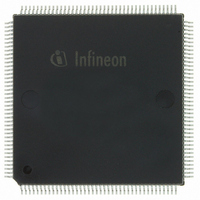PEB20320H-V34 Infineon Technologies, PEB20320H-V34 Datasheet - Page 74

PEB20320H-V34
Manufacturer Part Number
PEB20320H-V34
Description
IC CONTROLR 32-CH HDLC 160-MQFP
Manufacturer
Infineon Technologies
Datasheet
1.PEB20320H-V34.pdf
(252 pages)
Specifications of PEB20320H-V34
Function
Multichannel Network Interface Controller (MUNICH)
Interface
HDLC, V.110, X.30
Voltage - Supply
5V
Current - Supply
100mA
Operating Temperature
0°C ~ 70°C
Mounting Type
Surface Mount
Package / Case
160-BSQFP
Includes
Automatic Flag Detection, CRC Generation and Checking, Error Detection, Interframe-Time-Fill Change Detection
Lead Free Status / RoHS Status
Contains lead / RoHS non-compliant
Power (watts)
-
Number Of Circuits
-
Other names
PEB20320H-V34
PEB20320H-V34IN
PEB20320H-V34IN
Available stocks
Company
Part Number
Manufacturer
Quantity
Price
Company:
Part Number:
PEB20320H-V34
Manufacturer:
Infineon Technologies
Quantity:
10 000
- Current page: 74 of 252
- Download datasheet (3Mb)
User’s Manual
In receive direction the MUNICH32 reads a receive descriptor, calculates the data
address, writes the current receive descriptor address into the CCS, and exchanges data
between the on-chip receive buffer and the external memory. After the data section has
been filled, the MUNICH32 writes the number of stored bytes (BNO) into the descriptor.
If a frame end has occurred the frame status is written into the descriptor and an interrupt
is generated. The frame status includes the CRC check results and transmission error
information like ‘non octet of bits’, ‘aborted frame’, ‘data overflow’, ‘maximum frame
length exceeded’ and ‘frames with less than or equal to two data bytes’. An activated
reception-hold in the descriptor prevents the MUNICH32 from processing the receive
data. The incoming frames are discarded until the hold is deactivated.
Because the MUNICH32 is divided into two non-synchronized parts by the on-chip
buffers, two different kinds of aborting a channel transmission are implemented.
– Normal abort: This abort of a receive or transmit channel is processed in the
– Fast abort: A fast abort is performed by the DMA controller and does not disturb the
For initialization and control the host sets up a Control and Configuration Section (CCS),
including the action specification, interrupt queue specification, time slot assignment and
the channel specification. The host initiates an action, e.g. reconfiguration, change of the
channel mode, reset or switching of a test loop by updating the CCS and issuing an
action request pulse. When the action request pulse is detected by the MUNICH32 it
reads the control start address, then the action specification and, if necessary, additional
information from the CCS. After execution, the action request is acknowledged by an
interrupt.
MUNICH32 indicates an interrupt by activating the interrupt line and storing the interrupt
information including the corresponding channel number in the interrupt queue. The
interrupt queue is a circular buffer; MUNICH32 starts to write the interrupt queue
specification and fills it successively in a circular manner. The host has to allocate
sufficient buffer size and to empty the buffer fast enough in order to prevent overflow of
the queue.
formatters of the serial interface. The interframe time-fill code is sent after aborting the
current issued frame. No accesses to the on-chip buffers are carried out, until the
abort is withdrawn. The handling of the link lists and the processing of the buffers by
the DMA controller are not affected by normal abort.
transmission on the serial interface. If this abort is detected the current descriptor is
suspended with an abort status immediately followed by a branching to the new
descriptor defined in the channel specification of the CCS.
74
Functional Description
PEB 20320
01.2000
Related parts for PEB20320H-V34
Image
Part Number
Description
Manufacturer
Datasheet
Request
R

Part Number:
Description:
Multichannel Network Interface Controller For Hdlc
Manufacturer:
Infineon Technologies Corporation
Datasheet:

Part Number:
Description:
Manufacturer:
Infineon Technologies AG
Datasheet:

Part Number:
Description:
Manufacturer:
Infineon Technologies AG
Datasheet:

Part Number:
Description:
Manufacturer:
Infineon Technologies AG
Datasheet:

Part Number:
Description:
Manufacturer:
Infineon Technologies AG
Datasheet:

Part Number:
Description:
Manufacturer:
Infineon Technologies AG
Datasheet:

Part Number:
Description:
Manufacturer:
Infineon Technologies AG
Datasheet:

Part Number:
Description:
Manufacturer:
Infineon Technologies AG
Datasheet:

Part Number:
Description:
16-bit microcontroller with 2x2 KByte RAM
Manufacturer:
Infineon Technologies AG
Datasheet:

Part Number:
Description:
NPN silicon RF transistor
Manufacturer:
Infineon Technologies AG
Datasheet:

Part Number:
Description:
NPN silicon RF transistor
Manufacturer:
Infineon Technologies AG
Datasheet:

Part Number:
Description:
NPN silicon RF transistor
Manufacturer:
Infineon Technologies AG
Datasheet:

Part Number:
Description:
NPN silicon RF transistor
Manufacturer:
Infineon Technologies AG
Datasheet:

Part Number:
Description:
Si-MMIC-amplifier in SIEGET 25-technologie
Manufacturer:
Infineon Technologies AG
Datasheet:

Part Number:
Description:
IGBT Power Module
Manufacturer:
Infineon Technologies AG
Datasheet:











